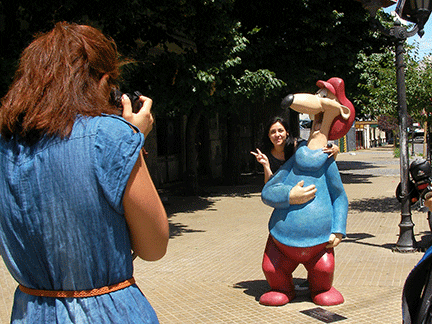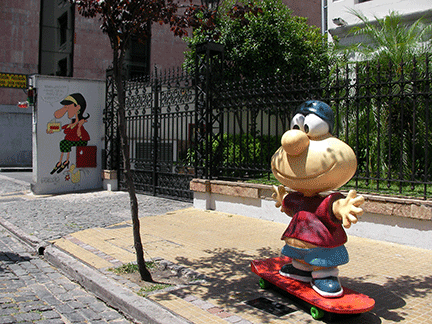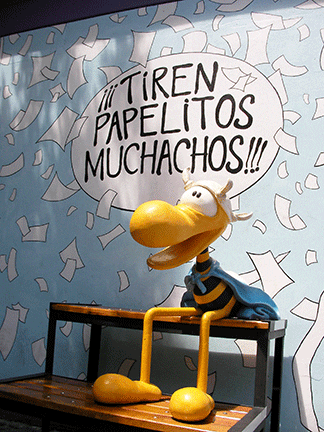Are you ready to embark on a journey through the vibrant world of Argentine comics? The Comic Walk in Buenos Aires offers a unique and immersive experience, allowing you to explore the rich cultural heritage of Argentina through its beloved comic strip characters. From the iconic Mafalda to the mischievous Gaturro, this walk will awaken your inner child and provide a fascinating insight into Argentine humor and imagination. In this ultimate guide, we will take you on a virtual tour of the Comic Walk, highlighting the key characters, their creators, and the locations where you can find their larger-than-life sculptures. So, grab your virtual walking shoes and let’s dive into the colorful world of Argentine comics!
1. Mafalda – The Heart and Soul of Argentine Comics
Let’s begin our journey with the most famous and beloved Argentine comic strip character of all time – Mafalda. Created by Quino and born in San Telmo in 1964, Mafalda is an endearing six-year-old girl with a keen sense of idealism and a deep concern for humanity and world peace. Her thoughtful and often amusing observations about life and society have captivated readers around the globe. As you start your Comic Walk, you’ll find Mafalda’s sculpture at the corner of Defensa and Chile, where you can sit beside her on a bench and capture a memorable photo.
If you want to know more about it: Mafalda: Ground-Breaking Comic Strip That Challenged Argentina and Helped Us Learn Spanish
2. Isidoro Cañones – The Playboy and His Enchanting World
Continuing our walk, we encounter Isidoro Cañones, a charismatic playboy who has entertained generations of Argentine readers since his creation in 1953 by Dante Quinterno. Isidoro’s carefree and adventurous lifestyle, accompanied by his loyal dog Cachorra, transports us to a bygone era. You can find Isidoro Cañones’ sculpture at the corner of Chile and Balcarce, where he stands proudly, exuding his inimitable charm.
3. Larguirucho – A Forgetful Rascal with a Heart of Gold
Next, we meet Larguirucho, a lovable and somewhat forgetful rodent created by Manuel García Ferré in 1955. Despite his occasional absent-mindedness, Larguirucho’s good-hearted nature shines through in his humorous and often endearing adventures. You’ll find his sculpture on Balcarce, between Mexico and Venezuela, inviting you to immerse yourself in his world of whimsy.
4. Matías – An Observant Boy with a Curious Mind
As we continue our journey, we encounter Matías, a normal boy from a typical urban family, created by Fernando Sendra in 1993. Matías’s keen observations and disconcerting questions about adult life reflect the simplicity and innocence of childhood. You can spot Matías on Balcarce 500, where he stands with his skateboard, ready to embark on new adventures.
5. Hugo “El Loco” Chávez – A Journalist, Football Fan, and Ladies’ Man
Prepare to meet Hugo “El Loco” Chávez, an Argentine journalist known for his amorous conquests and unwavering support for Racing Club, a prominent football team. Created by Carlos Trillo and Horacio Altuna in 1975, this character offers a unique perspective on the realities of everyday life in Argentina. You’ll find his sculpture at the intersection of Balcarce and Venezuela, where he awaits, capturing the essence of his charismatic personality.
6. Clemente – The Field of Dreams and Humor
Our journey takes a delightful turn as we encounter Clemente, a striped, armless character created by Caloi in 1973. Clemente’s passion for football, irreverent humor, and witty social commentary have made him a beloved figure in Argentine comics. You can find his sculpture at the corner of Balcarce and Belgrano, where he stands amidst cheers and laughter, reflecting the spirit of the game.
7. Chicas Divito – The Glamour and Sensuality of Argentine Women
Let’s pause for a moment to appreciate the beauty and sensuality of the Chicas Divito, a collection of stylized female characters created by Guillermo Divito. These iconic women, known for their fashionable allure, represent the timeless elegance of Argentine women. You can find their sculptures on Balcarce and Belgrano, celebrating their captivating charm and undeniable charisma.
8. Don Fulgencio – Embracing the Child Within
Our journey takes a whimsical turn as we meet Don Fulgencio, a character created by Lino Palacio in 1938. Don Fulgencio, known as “the man who never had a childhood,” embodies innocence, simplicity, and the playful spirit that resides in all of us. His sculpture awaits you at the corner of Belgrano and Paseo Colón, inviting you to embrace your inner child and revel in the joy of imagination.
9. Patoruzú – The Noble Defender of Justice
Prepare to be captivated by Patoruzú, the last Tehuelche Indian chief, created by Dante Quinterno in 1936. With superhuman strength and unwavering dedication to justice, Patoruzú became the first comic strip superhero in Argentina. His sculpture stands proudly in Agustín P. Justo Square, located at the intersection of Paseo Colón and Belgrano, symbolizing his noble spirit and indomitable courage.
10. Gaturro – A Dreamer, Romantic, and Mischief-maker
Our journey concludes with Gaturro, the orange feline created by Nik in 1993. Gaturro, a dreamer, romantic, and mischievous rule-breaker, captivates readers with his imagination and ingenuity. You’ll find his sculpture on Paseo Colón and Moreno, where he awaits Agatha, his beloved companion. Take a moment to appreciate Gaturro’s charm and playfulness before concluding your Comic Walk adventure.
Conclusion: Discover the Magic of Argentine Comics
As you conclude your Comic Walk in Buenos Aires, you’ll have experienced the magic of Argentine comics and their iconic characters. From the thought-provoking Mafalda to the whimsical Gaturro, each sculpture along the walk represents a unique piece of Argentine culture and history. The Paseo de la Historieta invites you to connect with the creativity and imagination that have shaped generations of Argentine readers. So, whether you’re a comic enthusiast, a lover of art, or simply curious about Argentine culture, don’t miss the opportunity to embark on this enchanting journey through the world of Argentine comics.
Additional Information: How Vamos Academy Buenos Aires is helping travelers visiting Buenos Aires discover Buenos Aires and Learn Spanish in Argentina
If you’re planning a trip to Buenos Aires, why not enhance your experience by learning Spanish? Vamos Academy Buenos Aires offers immersive Spanish language courses, allowing you to communicate and connect with locals on a deeper level. Whether you’re a beginner or an advanced learner, Vamos Academy provides personalized lessons and cultural activities that will enrich your stay in Buenos Aires. Immerse yourself in the vibrant culture, explore the city’s hidden gems, and unlock new opportunities by speaking the language of the locals. Visit Vamos Academy Buenos Aires to learn more about their courses and start your language learning journey today.


Join the conversation on social:
Follow us on Instagram for daily updates and behind-the-scenes glimpses of the Comic Walk and other exciting adventures in Buenos Aires. Share your own experiences using the hashtag #ComicWalkBA and let us know which comic character resonates with you the most. We look forward to hearing your stories and seeing your photos as you embark on this unique journey through the vibrant world of Argentine comics.
More about Buenos Aires Comic Walk:
When talking about Argentine culture, beef, tango, football and gaucho typically come to mind. There is actually another aspect that one rarely talks about, and that is the historietas (Argentine comics). They provide a great perspective and an interesting look into the very essence of the Argentine culture, particularly their humor and world view.
Argentina produces many acclaimed cartoon/comic strip artists. The most famous one has to be Quino, real name Joaquín Salvador Lavado, who has created Mafalda, a comic strip that has been made into many book editions and translated into more than 30 languages.
While Mafalda is the most widely recognized Argentine comic character, there are actually many other creations that have shaped and put Argentina on the comic world map. With such notable cultural heritage, the Buenos Aires city government has started the ‘Paseo de La Historieta‘ (The Comic ‘Strip’). It is an ongoing project where they designate a ‘path’ and dot it with larger-than-life-size statue of the most well-known Argentine comic characters. So far, they have inaugurated 5 out of the 10 planned statues with Mafalda, being the first one, at the path’s starting point which is also her ‘birthplace’ in San Telmo.
In order for you to enjoy more when you by chance or deliberately run into these characters on the streets, here is a brief introduction of who they are and why they have such a special place in the hearts of every Argentine.


Mafalda – The most famous of all Argentine comic strip characters, this six-year-old was “born” in San Telmo in 1964 in a comic strip created by Quino. She is sensible, idealistic, and cares about humanity and world peace. She often confounds her parents by asking about very mature and complex topics.
Isidoro Cañones – Created in 1935 by Dante Quinterno, this character is a loveable man of leisure. He is also rich, irresponsible, and avoids settling down with a real job. He’s a memorable and important character because he represents a particular era and social class here in Argentina.


Larguirucho – Manuel García Ferré created this loveable rodent in 1955; he’s a somewhat forgetful rascal, but a good guy at heart – even if he doesn’t always act like it! He’s widely recognized because he appears in nearly all of Ferré’s comics and also stars in his own tragicomic tales, in which things never go well for him.


Matías – Fernando Sendra created the comic strip, “Yo, Matías” in 1993 starring Matías, a normal boy from a typical urban family. He’s very observant, and often asks disconcerting questions that reflect the simplicity of children’s thoughts on adult life, often upsetting his mother. This strip is still running in the Argentine newspaper, Clarín.
Hugo “El Loco” Chávez (no relation to the Venezuelan President) – In 1975 Carlos Trillo (scriptwriter) and Horacio Altuna (artist) brought this character to life in a comic that ran for 12 years and was briefly a television series in 1978. El Loco Chávez is an Argentine journalist, known for his female conquests and as an hincha (fan) of the football team Racing Club. Through his adventures and encounters, he narrates the reality of day-to-day life in Argentina.
Chicas Divito – This name references the various female characters found in Guillermo Divito’s comic Rico Tipo (1944). These women are known for being drawn in a highly stylized manner. They’re all very fashionable and are meant to represent the sensuality and femininity of Argentine women. Today, calling a woman “una chica divito” is to say she’s synonymous with beauty and glamor.
Don Fulgencio – Called “the man who never had a childhood”, he was created in 1938 by Lino Palacio. He’s innocent, easygoing, and is a popular character because he represents the child within.


Clemente – Caloi (Carlos Loiseau) gave this bird-like character life in 1973, and even though he isn’t really human, he’s a representation of the Argentine man: he’s a great lover of football and of women. Both sour and passionate, he represents the creole liveliness and the national sense of humor. He’s an irrational fanatic of blue and white (Argentina’s colors) and never misses a game!
Patoruzú – Another creation by Dante Quinterno (1936), he’s the last Tehuelche Indian chief (a tribe from Patagonia) and has superhuman strength and speed, making him the first comic strip superhero. He is generous, brave, solitary, and a defender of justice. He possesses all of the nobility and integrity of a man of the country.
Gaturro – This orange feline was created in 1993 by Nik and can still be found in the Argentine newspaper, La Nación, as well as in 3D on the big screen. He’s a dreamer and a romantic, but also a curious and troublesome rule-breaker. He’s the pet of a modern middle-class Argentine family, and he’s best known for his imagination and ingenuity.
Profesores de ingles en Buenos Aires




